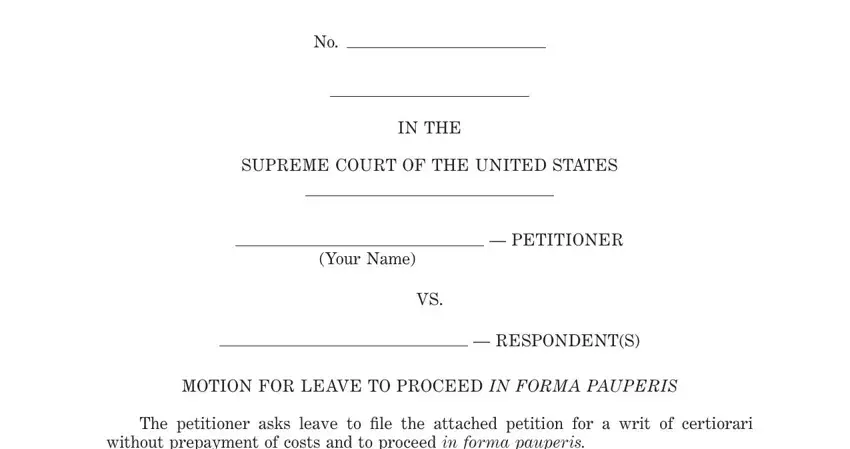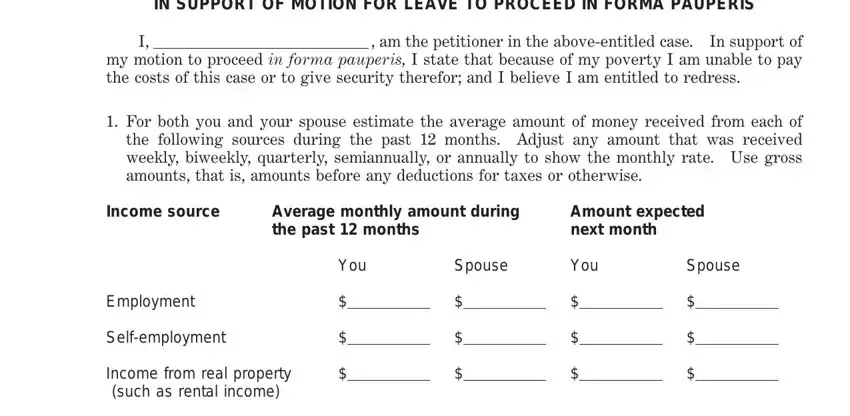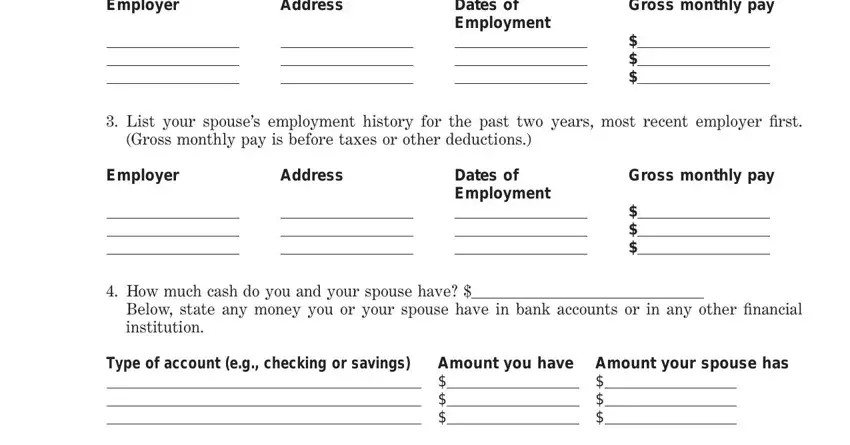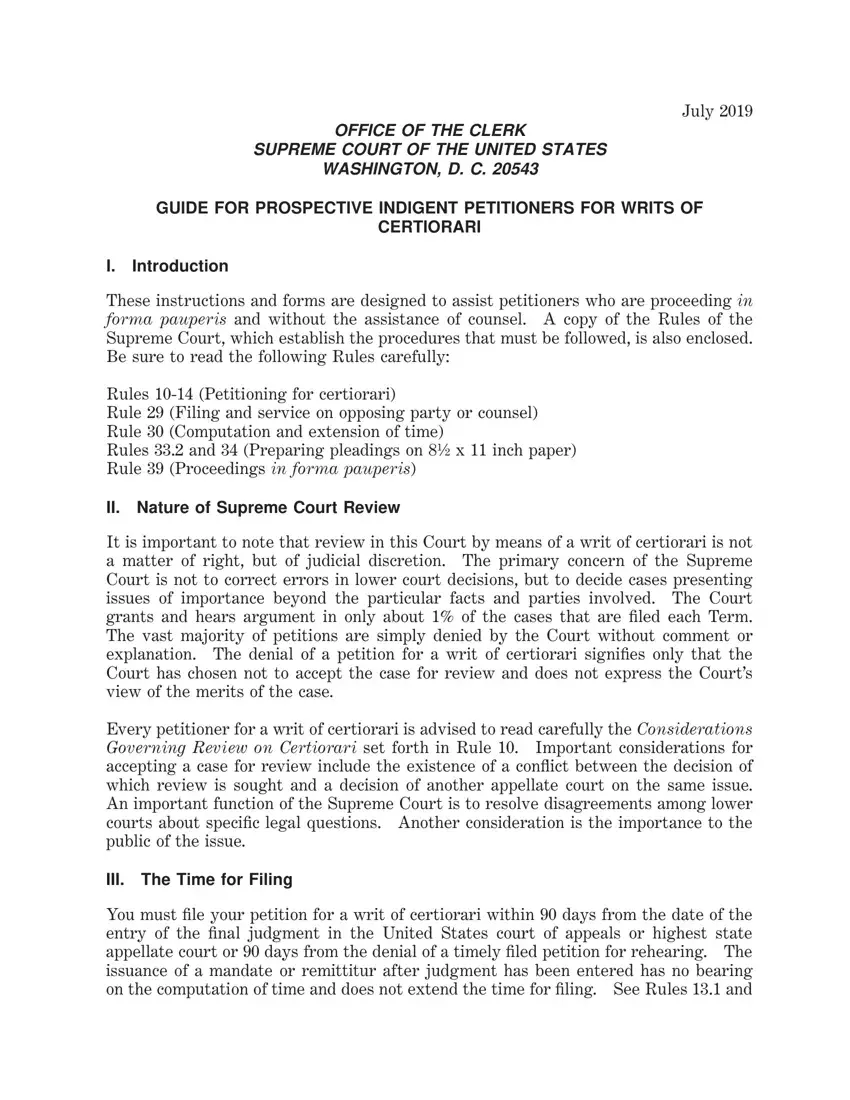July 2019
OFFICE OF THE CLERK
SUPREME COURT OF THE UNITED STATES
WASHINGTON, D. C. 20543
GUIDE FOR PROSPECTIVE INDIGENT PETITIONERS FOR WRITS OF
CERTIORARI
I. Introduction
These instructions and forms are designed to assist petitioners who are proceeding in forma pauperis and without the assistance of counsel. A copy of the Rules of the Supreme Court, which establish the procedures that must be followed, is also enclosed. Be sure to read the following Rules carefully:
Rules 10-14 (Petitioning for certiorari)
Rule 29 (Filing and service on opposing party or counsel)
Rule 30 (Computation and extension of time)
Rules 33.2 and 34 (Preparing pleadings on 81⁄2 x 11 inch paper)
Rule 39 (Proceedings in forma pauperis)
II. Nature of Supreme Court Review
It is important to note that review in this Court by means of a writ of certiorari is not a matter of right, but of judicial discretion. The primary concern of the Supreme Court is not to correct errors in lower court decisions, but to decide cases presenting issues of importance beyond the particular facts and parties involved. The Court grants and hears argument in only about 1% of the cases that are filed each Term. The vast majority of petitions are simply denied by the Court without comment or explanation. The denial of a petition for a writ of certiorari signifies only that the Court has chosen not to accept the case for review and does not express the Court’s view of the merits of the case.
Every petitioner for a writ of certiorari is advised to read carefully the Considerations Governing Review on Certiorari set forth in Rule 10. Important considerations for accepting a case for review include the existence of a conflict between the decision of which review is sought and a decision of another appellate court on the same issue. An important function of the Supreme Court is to resolve disagreements among lower courts about specific legal questions. Another consideration is the importance to the public of the issue.
III. The Time for Filing
You must file your petition for a writ of certiorari within 90 days from the date of the entry of the final judgment in the United States court of appeals or highest state appellate court or 90 days from the denial of a timely filed petition for rehearing. The issuance of a mandate or remittitur after judgment has been entered has no bearing on the computation of time and does not extend the time for filing. See Rules 13.1 and
13.3.Filing in the Supreme Court means the actual receipt of paper documents by the Clerk; or their deposit in the United States mail, with first-class postage prepaid, on or before the final date allowed for filing; or their delivery to a third-party commer- cial carrier, on or before the final date allowed for filing, for delivery to the Clerk within 3 calendar days. See Rule 29.2.
IV. What To File
Unless you are an inmate confined in an institution and not represented by counsel, file:
—An original and ten copies of a motion for leave to proceed in forma pauperis and an original and 10 copies of an affidavit or declaration in support thereof. See Rule 39.
—An original and 10 copies of a petition for a writ of certiorari with an appendix consisting of a copy of the judgment or decree you are asking this Court to review including any order on rehearing, and copies of any opinions or orders by any courts or administrative agencies that have previously considered your case. See Rule 14.1(i).
—One affidavit or declaration showing that all opposing parties or their counsel have been served with a copy of the papers filed in this Court. See Rule 29.
If you are an inmate confined in an institution and not represented by counsel, you need file only the original of the motion for leave to proceed in forma pauperis, affidavit or declaration when needed in support of the motion for leave to proceed in forma pau- peris, the petition for a writ of certiorari, and proof of service.
If the court below appointed counsel in the current proceeding, no affidavit or declara- tion is required, but the motion should cite the provision of law under which counsel was appointed, or a copy of the order of appointment should be appended to the motion. See Rule 39.1.
The attached forms may be used for the original motion, affidavit or declaration, and petition, and should be stapled together in that order. The proof of service should be included as a detached sheet, and the form provided may be used.
The Court’s practice is to scan and make available on its website most filings submitted by litigants representing themselves. The Court scans petitions, motions to proceed in forma pauperis, proofs of service, and the portion of an appendix that includes relevant lower court opinions and rulings. While the Court does not scan other por- tions of an appendix from a pro se litigant, the entire appendix is fully a part of the Court’s record and is available to the Justices.
On the same page, list all cases in other courts that are directly related to the case in this Court. A case is dirrctly related if it arises from the same trial court case as the case in this Court (including the proceedings directly on review in this case), or if it challenges the same criminal conviction or sentence as is challenged in this Court,
whether on direct appeal or through state or federal collateral proceedings. Below is an example of the format that should be used for the list:
V. Page Limitation
The petition for a writ of certiorari may not exceed 40 pages excluding the pages that precede Page 1 of the form. The documents required to be contained in the appendix to the petition do not count toward the page limit. See Rule 33.2(b).
VI. Redaction of Personal Information
Pursuant to Rule 34.6, certain types of personal information should not be included in filings. For example, social security numbers and taxpayer identification numbers should be redacted so that only the last four digits of the number are included, and the names of minor children should be redacted so that only initials are included. In gen- eral, Rule 34.6 adopts the redaction practices that are applicable to cases in the lower federal courts. See, e.g., Federal Rule of Civil Procedure 5.2.
VII. Method of Filing
All documents to be filed in this Court must be addressed to the Clerk, Supreme Court of the United States, Washington, D. C. 20543 and must be served on opposing parties or their counsel in accordance with Rule 29.
INSTRUCTIONS FOR COMPLETING FORMS
I.Motion for Leave to Proceed In Forma Pauperis - Rule 39
A.On the form provided for the motion for leave to proceed in forma pauperis, leave the case number blank. The number will be assigned by the Clerk when the case is docketed.
B.On the line in the case caption for “petitioner”, type your name. As a pro se petitioner, you may represent only yourself. On the line for “respondent”, type the name of the opposing party in the lower court. If there are multiple respondents, enter the first respondent, as the name appeared on the lower court decision, followed by “et al.” to indicate that there are other respondents. The additional parties must be listed in the LIST OF PARTIES section of the petition.
C.If the lower courts in your case granted you leave to proceed in forma pau- peris, check the appropriate space and indicate the court or courts that allowed you to proceed in forma pauperis. If none of the lower courts granted you leave to proceed in forma pauperis, check the block that so indicates.
D.Sign the motion on the signature line.
II.Affidavit or Declaration in Support of Motion for Leave to Proceed In Forma Pauperis
On the form provided, answer fully each of the questions. If the answer to a question is “0,” “none,” or “not applicable (N/A),” enter that response. If you need more space to answer a question or to explain your answer, attach a separate sheet of paper, identified with your name and the question number. Unless each question is fully answered, the Clerk will not accept the petition. The form must either be notarized or be in the form of a declaration. See 28 U. S. C. § 1746.
III. Cover Page - Rule 34
When you complete the form for the cover page:
A.Leave case number blank. The number will be assigned by the Clerk when the case is docketed.
B.Complete the case caption as you did on the motion for leave to proceed in forma pauperis.
C.List the court from which the action is brought on the line following the words “on petition for a writ of certiorari to.” If your case is from a state court, enter the name of the court that last addressed the merits of the case. For example, if the highest state court denied discretionary review, and the state court of appeals affirmed the decision of the trial court, the state court of appeals should be listed. If your case is federal, the United States court of appeals that decided your case will always be listed here.
D.Enter your name, address, and telephone number in the appropriate spaces.
IV. Question(s) Presented
On the page provided, enter the question or questions that you wish the Court to review. The questions must be concise. Questions presented in cases accepted for review are usually no longer than two or three sentences. The purpose of the question presented is to assist the Court in selecting cases. State the issue you wish the Court to decide clearly and without unnecessary detail.
V. List of Parties and Related Cases
On the page provided, check either the box indicating that the names of all parties appear in the caption of the case on the cover page or the box indicating that there are additional parties. If there are additional parties, list them. Rule 12.6 states that all parties to the proceeding whose judgment is sought to be reviewed shall be deemed parties in this Court, and that all parties other than petitioner shall be respondents. The court whose judgment you seek to have this Court review is not a party.
On the same page, list all cases in other courts that are directly related to the case in this Court. A case is “directly related” if it arises from the same trial court case as the case in this Court (including the proceedings directly on review in this case), or if it challenges the same criminal conviction or sentence as is challenged in this Court, whether on direct appeal or through state or federal collateral proceedings. Below is an example of the format that should be used for this list:
·Smith v. Jones, No. 18-cv-200, U. S. District Court for the Western District of Pennsylvania. Judgment entered Oct. 1, 2018.
·Smith v. Jones, No. 18-1200, U. S. Court of Appeals for the Third Circuit. Judg- ment entered Apr. 15, 2019.
VI. Table of Contents
On the page provided, list the page numbers on which the required portions of the petition appear. Number the pages consecutively, beginning with the “Opinions Below” page as page 1.
VII. Index of Appendices
List the description of each document that is included in the appendix beside the appro- priate appendix letter. Mark the bottom of the first page of each appendix with the appropriate designation, e.g., “Appendix A.” See Rule 14.1 pertaining to the items to be included in the appendix.
A. Federal Courts
If you are asking the Court to review a decision of a federal court, the decision of the United States court of appeals should be designated Appendix A. Appendix A should be followed by the decision of the United States District Court and the findings and recommendations of the United States magistrate judge, if there were any. If the United States court of appeals denied a timely filed petition for rehearing, a copy of that order should be appended next. If you are seeking review of a decision in a habeas corpus case, and the decision of either the United States District Court or the United States Court of Appeals makes reference to a state court decision in which you were a party, a copy of the state court decision must be included in the appendix.
B. State Courts
If you are asking the Court to review a decision of a state court, the decision of which review is sought should be designated Appendix A. Appendix A should be followed by the decision of the lower court or agency that was reviewed in the decision designated Appendix A. If the highest court of the state in which a decision could be had denied discretionary review, a copy of that order should follow. If an order denying a timely filed petition for rehearing starts the run- ning of the time for filing a petition for a writ of certiorari pursuant to Rule 13.3, a copy of the order should be appended next.
As an example, if the state trial court ruled against you, the intermediate court of appeals affirmed the decision of the trial court, the state supreme court denied discretionary review and then denied a timely petition for rehearing, the appen- dices should appear in the following order:
Appendix A Decision of State Court of Appeals
Appendix B Decision of State Trial Court
Appendix C Decision of State Supreme Court Denying Review
Appendix D Order of State Supreme Court Denying Rehearing
VIII. Table of Authorities
On the page provided, list the cases, statutes, treatises, and articles that you reference in your petition, and the page number of your petition where each authority appears.
IX. Opinions Below
In the space provided, indicate whether the opinions of the lower courts in your case have been published, and if so, the citation for the opinion below. For example, opin- ions of the United States courts of appeals are published in the Federal Reporter. If the opinion in your case appears at page 100 of volume 30 of the Federal Reporter, Third Series, indicate that the opinion is reported at 30 F. 3d 100. If the opinion has been designated for publication but has not yet been published, check the appropriate space. Also indicate where in the appendix each decision, reported or unreported, appears.
X. Jurisdiction
The purpose of the jurisdiction section of the petition is to establish the statutory source for the Court’s jurisdiction and the dates that determine whether the petition is timely filed. The form sets out the pertinent statutes for federal and state cases. You need provide only the dates of the lower court decisions that establish the timeli- ness of the petition for a writ of certiorari. If an extension of time within which to file the petition for a writ of certiorari was granted, you must provide the requested information pertaining to the extension. If you seek to have the Court review a deci- sion of a state court, you must provide the date the highest state court decided your case, either by ruling on the merits or denying discretionary review.
XI. Constitutional and Statutory Provisions Involved
Set out verbatim the constitutional provisions, treaties, statutes, ordinances and regu- lations involved in the case. If the provisions involved are lengthy, provide their cita- tion and indicate where in the Appendix to the petition the text of the provisions appears.
XII. Statement of the Case
Provide a concise statement of the case containing the facts material to the consider- ation of the question(s) presented; you should summarize the relevant facts of the case and the proceedings that took place in the lower courts. You may need to attach additional pages, but the statement should be concise and limited to the relevant facts of the case.
XIII. Reasons for Granting the Petition
The purpose of this section of the petition is to explain to the Court why it should grant certiorari. It is important to read Rule 10 and address what compelling reasons exist for the exercise of the Court’s discretionary jurisdiction. Try to show not only why the decision of the lower court may be erroneous, but the national importance of having the Supreme Court decide the question involved. It is important to show whether the decision of the court that decided your case is in conflict with the decisions of another appellate court; the importance of the case not only to you but to others similarly situated; and the ways the decision of the lower court in your case was errone- ous. You will need to attach additional pages, but the reasons should be as concise as possible, consistent with the purpose of this section of the petition.
XIV. Conclusion
Enter your name and the date that you submit the petition.
XV. Proof of Service
You must serve a copy of your petition on counsel for respondent(s) as required by Rule 29. If you serve the petition by first-class mail or by third-party commercial carrier, you may use the enclosed proof of service form. If the United States or any department, office, agency, officer, or employee thereof is a party, you must serve the Solicitor General of the United States, Room 5614, Department of Justice, 950 Pennsyl- vania Ave., N.W., Washington, D. C. 20530–0001. The lower courts that ruled on your case are not parties and need not be served with a copy of the petition. The proof of service may be in the form of a declaration pursuant to 28 U. S. C. § 1746.
No.
IN THE
SUPREME COURT OF THE UNITED STATES
— PETITIONER
(Your Name)
VS.
— RESPONDENT(S)
MOTION FOR LEAVE TO PROCEED IN FORMA PAUPERIS
The petitioner asks leave to file the attached petition for a writ of certiorari without prepayment of costs and to proceed in forma pauperis.
Please check the appropriate boxes:
Petitioner has previously been granted leave to proceed in forma pauperis in the following court(s):
Petitioner has not previously been granted leave to proceed in forma pauperis in any other court.
Petitioner’s affidavit or declaration in support of this motion is attached hereto.
Petitioner’s affidavit or declaration is not attached because the court below appointed counsel in the current proceeding, and:
The appointment was made under the following provision of law:
,or
a copy of the order of appointment is appended.
(Signature)

AFFIDAVIT OR DECLARATION
IN SUPPORT OF MOTION FOR LEAVE TO PROCEED IN FORMA PAUPERIS
I,, am the petitioner in the above-entitled case. In support of
my motion to proceed in forma pauperis, I state that because of my poverty I am unable to pay the costs of this case or to give security therefor; and I believe I am entitled to redress.
1.For both you and your spouse estimate the average amount of money received from each of the following sources during the past 12 months. Adjust any amount that was received weekly, biweekly, quarterly, semiannually, or annually to show the monthly rate. Use gross amounts, that is, amounts before any deductions for taxes or otherwise.
Income source |
Average monthly amount during |
Amount expected |
|
|
the past 12 months |
|
|
next month |
|
|
|
|
|
|
You |
Spouse |
You |
Spouse |
Employment |
|
|
$ |
|
$ |
|
$ |
|
$ |
|
Self-employment |
|
|
$ |
|
$ |
|
$ |
|
$ |
|
Income from real property |
$ |
|
$ |
|
$ |
|
$ |
|
(such as rental income) |
|
|
|
|
|
|
|
|
Interest and dividends |
|
|
$ |
|
$ |
|
$ |
|
$ |
|
Gifts |
|
|
$ |
|
$ |
|
$ |
|
$ |
|
Alimony |
|
|
$ |
|
$ |
|
$ |
|
$ |
|
Child Support |
|
|
$ |
|
$ |
|
$ |
|
$ |
|
Retirement (such as social |
$ |
|
$ |
|
$ |
|
$ |
|
security, pensions, |
|
|
|
|
|
|
|
|
|
|
annuities, insurance) |
|
|
|
|
|
|
|
|
|
|
Disability (such as social |
$ |
|
$ |
|
$ |
|
$ |
|
security, insurance payments) |
|
|
|
|
|
|
|
|
Unemployment payments |
$ |
|
$ |
|
$ |
|
$ |
|
Public-assistance |
|
|
$ |
|
$ |
|
$ |
|
$ |
|
(such as welfare) |
|
|
|
|
|
|
|
|
|
|
Other (specify): |
|
|
|
$ |
|
$ |
|
$ |
|
$ |
|
Total monthly income: $ |
|
$ |
|
$ |
|
$ |
2.List your employment history for the past two years, most recent first. (Gross monthly pay is before taxes or other deductions.)
Employer |
Address |
Dates of |
Gross monthly pay |
|
|
|
Employment |
$ |
|
|
|
|
|
|
|
|
|
|
|
|
|
|
$ |
|
|
|
|
|
|
|
$ |
|
|
3.List your spouse’s employment history for the past two years, most recent employer first. (Gross monthly pay is before taxes or other deductions.)
Employer |
Address |
Dates of |
Gross monthly pay |
|
|
|
Employment |
$ |
|
|
|
|
|
|
|
|
|
|
|
|
|
|
$ |
|
|
|
|
|
|
|
$ |
|
|
4.How much cash do you and your spouse have? $
Below, state any money you or your spouse have in bank accounts or in any other financial institution.
Type of account (e.g., checking or savings) Amount you have |
Amount your spouse has |
|
$ |
$ |
|
|
|
|
|
|
|
|
|
$ |
$ |
|
|
|
|
|
|
|
|
|
$ |
$ |
|
|
|
|
|
|
|
|
5.List the assets, and their values, which you own or your spouse owns. Do not list clothing and ordinary household furnishings.
|
|
|
|
|
|
|
|
|
|
Home |
|
Other real estate |
|
Value |
|
|
Value |
|
|
|
Motor Vehicle #1 |
|
Motor Vehicle #2 |
|
Year, make & model |
|
|
Year, make & model |
|
|
Value |
|
|
Value |
|
|
|
Other assets |
|
|
|
|
|
|
Description |
|
|
|
|
|
|
|
Value |
|
|
|
|
|
|
|









